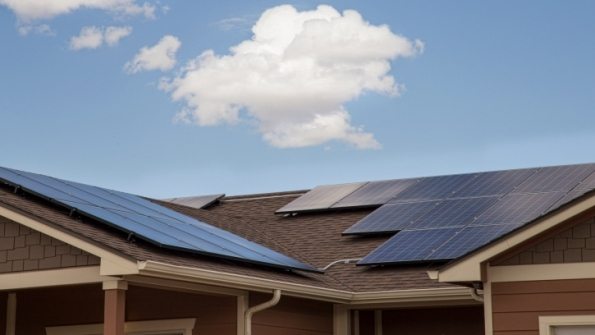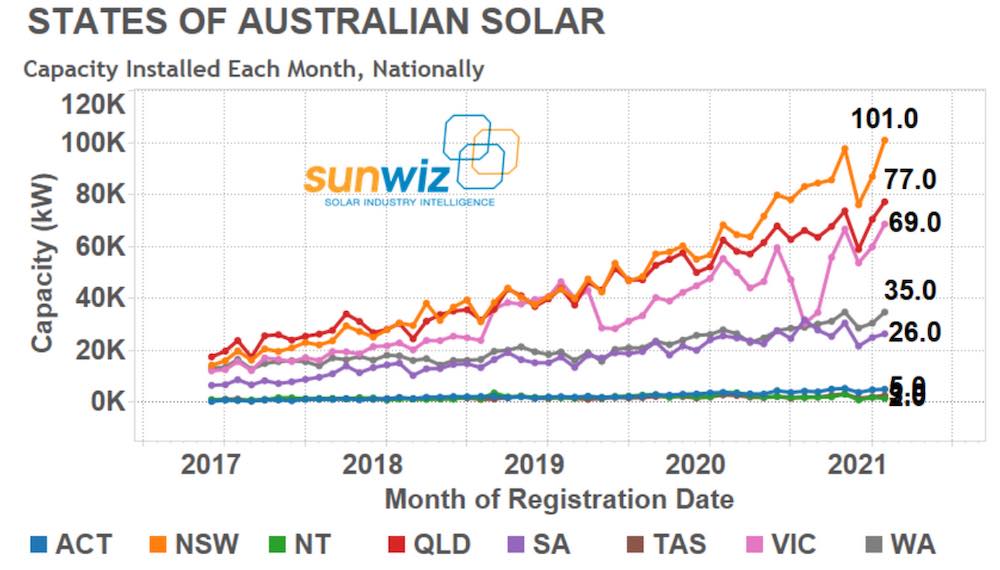
Australia has notched up yet another record for rooftop solar installations, with homes and businesses around the country installing 317MW of systems in March – an all-time high for national monthly installs.
The new monthly record was marked in the latest data from industry statisticians, SunWiz, taking the cumulative total to 13.9GW and keeping the nation on track to install a record-breaking 3.5GW for the year, compared to the Covid-defying 3GW installed in 2020.
“Q1 of 2021 shows a 26% lead over the same time last year for registered volume,” said SunWiz managing director Warwick Johnston in the March report. “If this trend continues to hold for 2021 we’ll see a larger capacity installed than 2020.”
On a month-by-month basis, the market showed a 12.4% increase in registration numbers from February, when a total of 285MW was installed.
This jump was buoyed by a boost from the commercial solar sector, which SunWiz says rebounded in March, across all capacity ranges, from its downward trend over the last couple of months.
On a state-by-state basis, the record month of March was driven by new all-time highs in no less than three states – New South Wales, Queensland and Victoria – with all other states and territories except for South Australia reaching their December levels.
SunWiz also notes that the average system size for residential solar broke its downward trend and crept up to 8.22kW for March, compared to 8.13kW in February.
This could begin to change, however, as installers and customers take in the implications of the draft proposal on a new solar tax for the residential market, following its publication by the Australian Energy Market Commission last month.
As RenewEconomy has reported, the AEMC proposes to charge households for solar power exported to the grid, most likely via a time-of-use tariff ranging up to 2c/kWh for exports in the middle of the day and costing a total of up to $100 per household per year.
The idea is to encourage networks to send “price signals” to help reduce rooftop solar congestion on the grid – or to encourage more households to install more battery storage and export less at peak times – and to direct costs of any rooftop solar-driven network upgrades to rooftop solar homes only.
SunWiz’s Johnston notes that the proposed rule change also encourages the rooftop solar industry to install smaller residential systems, more precisely designed to meet the energy needs of the household.
“Larger systems do not necessarily get charged more but oversized systems yielding higher export revenue would be significantly affected,” said Johnston in the new Sunwiz report.
“If the proposal passes (which may be years from now) we could expect to see the [8.22kW average] figure drop significantly as new cost-benefit models include the 2c/kWh tax and less installers oversize systems.
“Naturally other market conditions will play a role in defining average system size,” Johnston adds.
To read more about the AEMC’s proposed “solar tax” see: Modelling: How the proposed rooftop solar tax will affect solar households; Solar tax mythbuster: Here’s what you need to know; Energy Insiders Podcast: AEMC’s Ben Barr on new export rule; Solar Insiders Podcast: The good and bad of the solar export tax; Solar tax may be outrageous, but is it as bad as it sounds?

Sophie is editor of One Step Off The Grid and editor of its sister site, Renew Economy. Sophie has been writing about clean energy for more than a decade.



